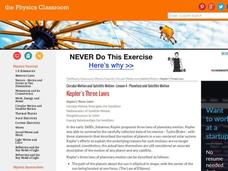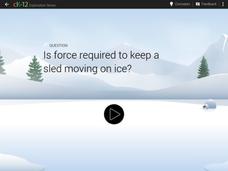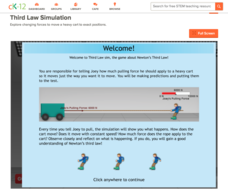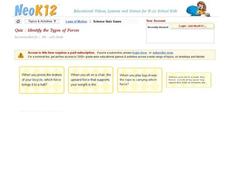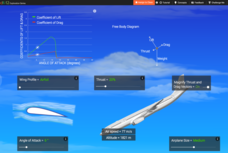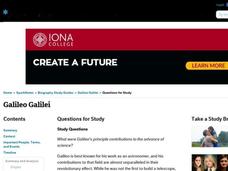Scholastic
Study Jams! Force & Motion
Set youngsters in motion when studying forces. This quick animated film stars Sam and Mia, two intelligent but cool kids who talk about forces and motion on the soccer field. Consider using this resource when preparing junior-high...
Scholastic
Study Jams! Newton's Second Law: Acceleration
Become a pinball wizard by understanding acceleration. Mia and Sam define acceleration for the audience and touch on the property of inertia. Get your physical science class up to speed by showing this little video, reviewing the...
Physics Classroom
Newton's Second Law
Physics formulas provide more interest than simple math equations thanks to an informative installment from the series on Newton's laws of motion. The formulas guide pupils' thinking about how varying a quantity affects the rest of the...
Physics Classroom
Kelper's Three Laws
A flipped classroom lesson introduces astrophysics fanatics to Kepler's three laws of planetary motion. After reading about the laws of ellipses, equal areas, and harmonies, and also learning how Newton's gravitation concepts come into...
CK-12 Foundation
First Law Simulation
Does Newton's First Law of Motion explain how to move a sled across ice? A simulation encourages scholars to decide if they should push, pull, or apply no force. Their decision moves a sled across the ice and to the home at the...
Physics Classroom
Recognizing Forces
A common complaint among physics scholars studying Newton's laws of motion concerns drawing free-body diagrams. To practice the required pre-requisite skills for free-body diagrams, individuals identify which forces act in specific...
Physics Classroom
Match That Free-Body Diagram
Pupils read a description of a physical situation and select the free-body diagram that best matches. As part of a series on applying Newton's Laws of Motion, scholars reinforce their skills applying forces and considering their relative...
CK-12 Foundation
Third Law Simulation
Keep calm and use the force! Joey pulls a cart and scholars adjust the force required to control the movement. Through simulating different scenarios, participants learn about Newton's Third Law. It includes analysis questions throughout...
CK-12 Foundation
Newton's Cannon
Gravity does more than keep our feet on the ground — it holds a satellite in orbit, too. Help learners understand the effects of gravity on an orbiting object through a simulation activity. Individuals adjust a launch speed and watch as...
Physics Classroom
Universal Gravitation
Are you feeling weighed down by your current gravitation presentation? Assign a hands-on interactive instead! Physics scholars work through a series of progressively harder questions about mass, distance, and gravity using an online...
PHET
Gravity Force Lab
Does size or mass impact gravitational pull? Scholars experiment with force pairs to answer that question. They can change the size, mass, and distance between the objects using an engaging simulatoin. This allows pupils to visualize the...
CK-12 Foundation
Bobsled
Bobsled riders' safety depends on skill ... and physics! Learners use a simulation to understand the physics behind the sport. They manipulate the speed, mass, and/or turn radius of the sled and watch the effects on the centripetal...
CK-12 Foundation
Unicycle
What is the steepness of a hill before a unicyclist slides down it rather than pedaling down it? The simulation graphs the wheel speed versus the unicycle speed as the rider goes down a hill. Scholars control the mass of the rider,...
Curated OER
Identify the Types of Forces
For this physical science worksheet, learners complete an 8 question multiple choice online interactive quiz about the types of forces and the laws of motion. The quiz may also be printed and completed on paper.
CK-12 Foundation
Hot Air Balloon
How can people control a hot air balloon? The simple simulation allows scholars to adjust the payload mass, burner, and vent position on a hot air balloon and observe the changes in velocity and altitude over time. Challenge questions...
CK-12 Foundation
Everglades Airboat
How does an airboat move when there isn't a motor in the water? The simulation teaches the forces related to the thrust and drag on an airboat. Scholars vary the boat mass and thrust force in order to view graphs of the changing force...
CK-12 Foundation
Elevator
Do you weigh slightly less when an elevator first starts its descent? The simulation teaches the change in the force based on the acceleration, constant speed, or deceleration of an elevator. Scholars control the mass and acceleration...
CK-12 Foundation
Pirate Ship
Everything that happens is an interaction, from the wind blowing a sail to a cannon ball being thrust out of a cannon. A simulation shows the interactions involving a sail, air, ball, pirate, cannon, deck, ocean, and the Earth and...
CK-12 Foundation
Airplane
How does an airplane control its take off and descent? Scholars explore the forces acting on an airplane and control the angle of attack, wing profile, thrust, and airplane size. They learn about lift, drag, thrust, gravity, and the...
CK-12 Foundation
Horse and Cart
Can a horse pull more than its weight? A simple simulation answers this question and more. Pupils adjust the mass in a cart, the mass of the horse, the acceleration of the horse, and the angle of the tension rope between the horse and...
CK-12 Foundation
Bowling Alley
Sometimes it appears that a bowling ball slides down the alley rather than rolling, while other times it appears to switch rolling directions at some point. Scholars control the bowling ball size, initial rotation, initial speed, and...
Curated OER
Galileo Galilei Questions for Study
In this online interactive philosophy instructional activity, students respond to 10 short answer and essay questions about Galileo's contributions to science.
Wisc-Online
Wisc Online: Physics: Newton's Laws
Play this game to review for a physical science test on Newton's laws.
CK-12 Foundation
Ck 12 Exploration Series: Simulations: Physics: Everglades Airboat
[Free Registration/Login Required] Learn about Newton's 2nd Law- the relationship between force, mass, and acceleration, for a wind-powered boat.


